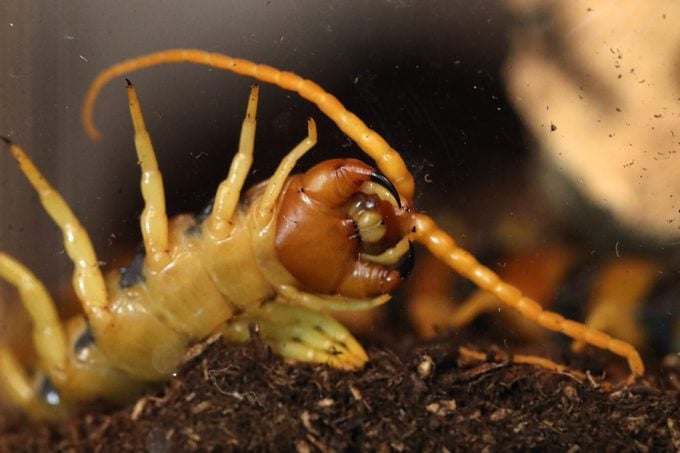Get the scoop on giant (desert) centipedes: What they are, where they can be found, if they're dangerous and what to do if you happen to run into one.

What To Know About Giant Centipedes

The giant desert centipede (AKA the giant Arizona desert centipede) is commonly found slithering around the arid, hot Southwest region of the U.S. and parts of northern Mexico. As scary-looking as they can be, giant centipedes are also highly beneficial for maintaining the balance of our ecosystem. Find out more about these ominous-looking creatures.
On This Page
What Is the Giant (Desert) Centipede?
Nocturnal in nature, giant centipedes, like millipedes, are characterized by hard exoskeletons and jointed appendages. The giant desert centipede is a terrestrial, carnivorous arthropod that feeds on insects, lizards, frogs, rodents and other small animals.
Averaging between six and eight inches long, adult giant desert centipedes have flat, orange segmented bodies (usually between 26 and 30 segments) with black heads and tails, making it difficult to distinguish which end is up. They have one pair of yellow legs for each segment — except for the first and last ones — and feel their way through life using antennae, since they don’t have eyes.
A predatory being, the giant centipede is agile and uses its many legs to move pretty fast. Centipedes have been clocked at approximately 1-1/3-ft. per second.
All 8,000 species of centipedes reproduce without copulation. The male deposits sperm on the ground, leaving it up to the female to locate the spot, AKA bundle, to lay her eggs for fertilization. She remains there, coiled around her eggs to protect them, until they hatch and the young ones are ready to set out on their own.
The giant desert centipede has a lifespan of about five years.
Are They the Biggest of Their Kind?
Not exactly, although they are pretty big. Experts at the Arizona-Sonora Desert Museum say the giant centipede, at six to eight inches, is larger than the common centipede, which is about four to five inches. But take heart: The giant desert centipede is no match for its South American cousin, the giant Amazonian centipede. Which grows to a horrifying one-foot long and can kill prey 15 times its size!
Factoid: A fossil of a 300 million year old centipede (Euphoberia) measured 39 inches long, making it one of the largest centipedes on record.
Do Giant Centipedes Bite?

No. They pinch.
Unique among arthropods, centipedes have forcipules on their first pair of legs that act as pincer-like “jaws” to hold onto and inject venom into their victims. Although many consider giant desert centipedes aggressive, they usually only sting if they perceive you as a threat or are hunting prey for their dinner.
Are Giant Centipedes Dangerous?
Yes and no.
Even if the giant centipedes’ venom is not considered deadly (similar to a bee sting), it still has the potential to be medically serious for small children, pets and people with allergies to bug bites.
If you are “bitten” by a giant centipede, your symptoms probably will go away in a few hours. If you experience severe swelling, redness, chills, fever and muscle weakness, seek medical attention immediately!
What To Do If You Encounter a Giant Centipede
Since giant desert centipedes are not fans of the hot sun, during daylight hours you’ll often find them sheltering in dank, cool places in your home or yard, such as under stacks of wood, bricks and potted plants. They become active as the sun goes down. Our best advice? Don’t bother it, so it won’t bother you.
If you should come face-to-face with a giant desert centipede inside your home, it may be a sign that others are present. We don’t recommend you handle one without proper protection. Though giant desert centipede’s aren’t poisonous to human beings, its pinch is said to be really, really painful!
Here are some ways to prevent giant centipedes from entering your home:
- Relocate firewood and compost piles that are near the house;
- Caulk cracks and other entry points in the foundation;
- Maintain screens and weather stripping;
- Reduce moisture and humidity;
- Eliminate their food source (cockroaches, ants, bed bugs, etc.).
If you’ve found a giant centipede inside your home, you can spray it with a pesticide or smash it with a broom. But rather than killing it, a more humane solution could be to use tongs and heavy-duty gloves to capture the centipede in a jar and release it in the yard, where it can keep garden pests in check.




















